-
 Bitcoin
Bitcoin $119800
1.38% -
 Ethereum
Ethereum $3873
3.25% -
 XRP
XRP $3.247
1.85% -
 Tether USDt
Tether USDt $1.001
0.02% -
 BNB
BNB $840.4
5.94% -
 Solana
Solana $190.0
2.55% -
 USDC
USDC $1.000
0.03% -
 Dogecoin
Dogecoin $0.2433
2.69% -
 TRON
TRON $0.3197
-0.05% -
 Cardano
Cardano $0.8367
1.39% -
 Sui
Sui $4.327
3.11% -
 Hyperliquid
Hyperliquid $44.00
0.31% -
 Stellar
Stellar $0.4461
1.76% -
 Chainlink
Chainlink $19.25
4.61% -
 Hedera
Hedera $0.2941
3.90% -
 Bitcoin Cash
Bitcoin Cash $598.4
6.89% -
 Avalanche
Avalanche $26.19
4.67% -
 Litecoin
Litecoin $115.1
0.50% -
 Shiba Inu
Shiba Inu $0.00001427
1.55% -
 Toncoin
Toncoin $3.379
2.01% -
 UNUS SED LEO
UNUS SED LEO $8.966
-0.16% -
 Ethena USDe
Ethena USDe $1.001
0.02% -
 Uniswap
Uniswap $11.04
4.16% -
 Polkadot
Polkadot $4.239
2.00% -
 Monero
Monero $324.6
0.36% -
 Bitget Token
Bitget Token $4.672
2.46% -
 Pepe
Pepe $0.00001294
2.69% -
 Dai
Dai $0.0000
0.01% -
 Cronos
Cronos $0.1443
2.71% -
 Aave
Aave $302.9
1.98%
What are the potential risks of USDT?
USDT's value faces risks from opaque reserves, lacking independent audits, counterparty failures, potential manipulation, and de-pegging; legal and operational challenges further increase uncertainty.
Feb 28, 2025 at 02:36 am
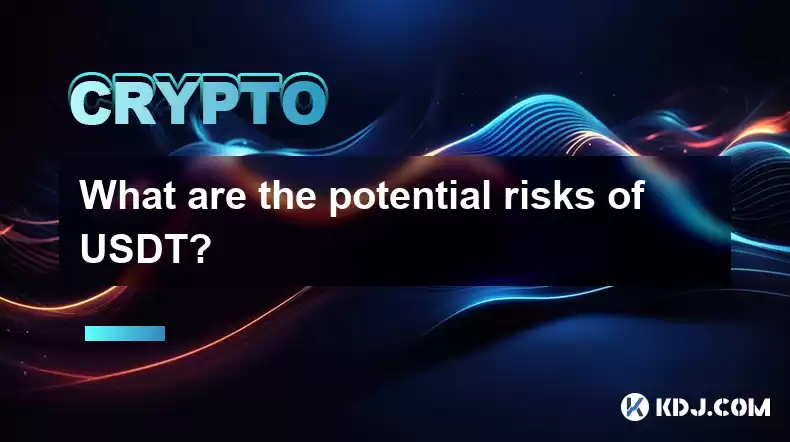
What are the Potential Risks of USDT?
Key Points:
- Tether's Reserve Transparency: The primary risk revolves around the composition and verification of Tether's reserves backing each USDT. Concerns persist regarding the actual amount of USD and other assets held to support the issued tokens.
- Auditing and Regulatory Scrutiny: The lack of consistent, independent audits has fueled skepticism. Regulatory actions and investigations pose a significant risk to Tether's stability and the value of USDT.
- Counterparty Risk: The risk that Tether's banking partners or other counterparties might fail, impacting Tether's ability to redeem USDT for USD.
- Market Manipulation Concerns: The large market capitalization of USDT makes it a potential target for manipulation, impacting its price stability and potentially causing significant market volatility.
- De-pegging Risk: The risk that the value of USDT will deviate significantly from its intended 1:1 peg to the US dollar. This can happen due to various factors, including loss of confidence, bank runs, and market manipulation.
- Legal and Operational Risks: Tether faces ongoing legal battles and operational challenges that could affect its ability to operate and maintain the peg.
Detailed Exploration of Potential Risks:
- Tether's Reserve Transparency and Composition:
The core risk associated with USDT lies in the uncertainty surrounding the composition of Tether's reserves. While Tether claims to hold sufficient reserves to back each USDT in circulation at a 1:1 ratio, the lack of consistently transparent and independently audited reports fuels significant skepticism within the cryptocurrency community. Concerns center on whether Tether truly holds the claimed amount of USD, or if a significant portion of the reserves consists of less liquid assets, such as commercial paper, corporate bonds, or other investments with varying degrees of risk. The lack of granular detail in the published attestations from accounting firms further exacerbates these concerns. Investors are left wondering about the specific holdings, their maturity dates, and the potential for losses if these assets depreciate in value. This lack of transparency raises questions about the solvency of Tether and the potential for a de-pegging event, where the market value of USDT falls significantly below $1. The opacity surrounding the reserves creates a significant risk profile for investors, making it difficult to accurately assess the true value and stability of USDT. Furthermore, the constant shifting of the composition of reserves, as reported by Tether, raises concerns about potential attempts to manage the appearance of solvency rather than ensuring genuine backing for all outstanding USDT. The absence of a truly independent and comprehensive audit conducted by a reputable accounting firm significantly amplifies the uncertainty and risk associated with investing in or using USDT. This uncertainty impacts not only USDT itself, but also the broader cryptocurrency market, as USDT is widely used as a stablecoin for trading and transactions.
- Auditing and Regulatory Scrutiny:
The absence of consistent, independent, and comprehensive audits of Tether's reserves is a major source of risk. While Tether has periodically published attestations from accounting firms, these have been criticized for lacking the detail and rigor expected of a full audit. The lack of transparency surrounding the auditing process and the limitations of the attestations leave significant doubts about the true state of Tether's finances. This lack of transparency makes it difficult for investors to assess the actual risk associated with holding USDT. Furthermore, regulatory scrutiny from various jurisdictions adds to the risk profile. Governments and regulatory bodies worldwide are increasingly focusing on the regulation of stablecoins, including USDT. Investigations and potential legal actions could lead to significant penalties, restrictions on operations, or even the complete shutdown of Tether's operations. The regulatory landscape for stablecoins is still evolving, and the uncertainty surrounding future regulations presents a considerable risk to USDT holders. Any negative regulatory outcome could severely impact the value of USDT, potentially leading to a significant de-pegging event and substantial losses for investors. The ongoing legal battles and regulatory challenges faced by Tether further exacerbate the risk, creating a climate of uncertainty and potentially impacting investor confidence. This uncertainty makes it crucial for investors to carefully consider the risks before utilizing or holding USDT.
- Counterparty Risk:
Counterparty risk is another significant concern associated with USDT. This refers to the risk that Tether's banking partners or other counterparties might fail or become insolvent, impacting Tether's ability to redeem USDT for USD. Tether relies on a network of banking partners to facilitate the exchange of USDT for fiat currency. If any of these partners experience financial difficulties or face regulatory issues, it could compromise Tether's ability to meet redemption requests. This could trigger a run on USDT, as users rush to redeem their tokens before the value declines. Such a scenario could lead to a rapid de-pegging of USDT from its intended $1 peg, causing significant losses for investors. The lack of transparency regarding Tether's banking relationships further exacerbates this risk, making it difficult to assess the financial health and stability of its counterparties. Understanding the interconnectedness of Tether's operations with its banking partners is crucial for assessing the overall risk profile of USDT. Diversification of banking partners could mitigate this risk, but the lack of information makes it challenging to determine the extent of such diversification. The potential for counterparty risk highlights the systemic risk associated with USDT and the importance of carefully considering the implications before investing in or utilizing the stablecoin.
- Market Manipulation Concerns:
Given USDT's large market capitalization and widespread use, it's susceptible to market manipulation. The potential for manipulation could significantly impact the price stability of USDT and create volatility in the broader cryptocurrency market. Large-scale buying or selling of USDT could artificially inflate or deflate its price, deviating it from its intended peg to the US dollar. Such manipulation could be orchestrated by individuals or entities with significant holdings of USDT, aiming to profit from price swings. The lack of robust regulatory oversight and the decentralized nature of the cryptocurrency market make it challenging to detect and prevent such manipulation effectively. The potential for manipulation adds another layer of risk to investing in or using USDT. The possibility of coordinated actions to artificially influence the price of USDT could lead to significant losses for investors who rely on its stability. The size and influence of USDT in the cryptocurrency market make it a prime target for manipulation, highlighting the need for caution and careful risk assessment.
- De-pegging Risk:
The risk of USDT de-pegging from its intended 1:1 peg to the US dollar is a significant concern. De-pegging can occur due to a variety of factors, including loss of confidence in Tether's reserves, a run on USDT, and market manipulation. If investors lose confidence in Tether's ability to maintain the peg, they may rush to sell their USDT, driving down its price. This could trigger a cascading effect, leading to a rapid and potentially significant de-pegging. Similarly, if a large number of users attempt to redeem their USDT for USD simultaneously, Tether may struggle to meet the demand, potentially causing a de-pegging event. Market manipulation, as discussed previously, could also contribute to a de-pegging scenario. The potential for de-pegging represents a substantial risk for investors, as it could lead to significant losses. The degree of risk is amplified by the lack of transparency and the absence of comprehensive audits. The potential for a sudden and dramatic de-pegging necessitates careful consideration of the inherent risks before using or investing in USDT.
- Legal and Operational Risks:
Tether faces ongoing legal battles and operational challenges that could affect its ability to operate and maintain the peg. These legal and operational risks add another layer of uncertainty to the already complex risk profile of USDT. Lawsuits and regulatory investigations could lead to significant financial penalties, operational restrictions, or even the complete shutdown of Tether's operations. Operational challenges, such as difficulties in maintaining banking relationships or managing the increasing volume of transactions, could also strain Tether's resources and potentially impact its ability to maintain the peg. The ongoing legal and operational uncertainties create a volatile environment for USDT, making it crucial for investors to carefully assess these risks before engaging with the stablecoin. The potential for unforeseen legal or operational setbacks adds to the overall uncertainty and risk associated with investing in or utilizing USDT.
FAQs:
Q: Is USDT truly backed 1:1 by the US dollar?
A: Tether claims a 1:1 backing, but the lack of consistent, independent audits raises serious questions about the actual composition and value of its reserves. While they publish attestations, these are not equivalent to full audits and lack the detail needed to fully verify the claim.
Q: What happens if USDT de-pegs from the US dollar?
A: A de-pegging event would likely lead to significant losses for investors holding USDT. The value of USDT could plummet, potentially resulting in substantial financial losses depending on the severity and duration of the de-pegging.
Q: Are there any alternatives to USDT?
A: Yes, several other stablecoins exist, each with its own set of risks and benefits. However, it's crucial to research and understand the specific risks associated with each alternative before investing. It is also important to note that many stablecoins face similar issues of transparency and regulation as USDT.
Q: How can I mitigate the risks associated with USDT?
A: There's no foolproof method to eliminate the risks, but you can mitigate them by diversifying your cryptocurrency holdings, avoiding over-reliance on any single stablecoin, and staying informed about regulatory developments and audits (or lack thereof). Careful monitoring of news and developments related to Tether is crucial.
Q: Is USDT regulated?
A: The regulatory status of USDT varies across jurisdictions. Some regulators are actively scrutinizing stablecoins, while others have yet to establish clear regulatory frameworks. The regulatory landscape is constantly evolving, adding to the uncertainty surrounding USDT.
Q: What should I do if I'm concerned about the risks of USDT?
A: If you're uncomfortable with the risks associated with USDT, consider diversifying your portfolio and exploring alternative stablecoins or assets. You should also carefully evaluate your risk tolerance and investment strategy before using or investing in any cryptocurrency, including USDT.
Disclaimer:info@kdj.com
The information provided is not trading advice. kdj.com does not assume any responsibility for any investments made based on the information provided in this article. Cryptocurrencies are highly volatile and it is highly recommended that you invest with caution after thorough research!
If you believe that the content used on this website infringes your copyright, please contact us immediately (info@kdj.com) and we will delete it promptly.
- Tether Gold's Meteoric Rise: Market Cap and Soaring Gold Demand
- 2025-07-28 10:30:11
- Reddit, Crypto, and Altcoins: Navigating the Hype in 2025
- 2025-07-28 10:30:11
- Bitcoin, Altcoin, Volume Surge: Decoding the Crypto Market's Latest Moves
- 2025-07-28 10:50:20
- Bitcoin, Altcoins, and 2024 Targets: A NYC Perspective
- 2025-07-28 10:50:21
- Moo Deng Meme-Coin Mania: ROI or Just Hype?
- 2025-07-28 10:55:13
- Ethereum, Injective, and Tokenized Stock: A New Era in DeFi?
- 2025-07-28 11:10:12
Related knowledge
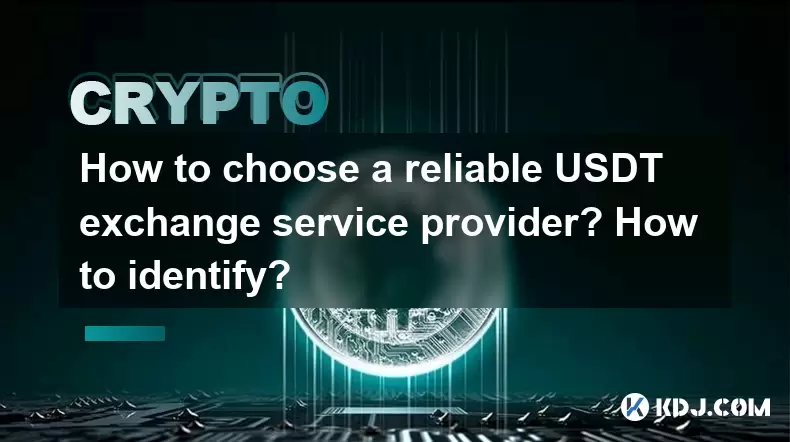
How to choose a reliable USDT exchange service provider? How to identify?
Jun 12,2025 at 03:15pm
Understanding the Role of USDT in Cryptocurrency TradingUSDT (Tether) is one of the most widely used stablecoins in the cryptocurrency market. It is d...
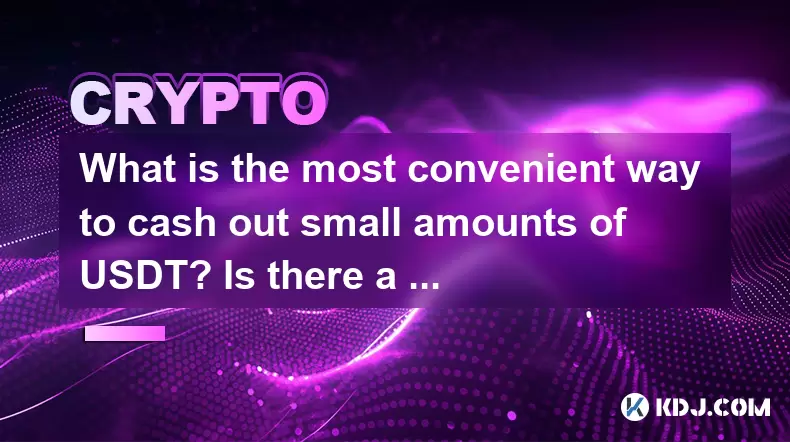
What is the most convenient way to cash out small amounts of USDT? Is there a shortcut?
Jun 11,2025 at 11:00pm
Understanding the Need to Cash Out Small USDT AmountsCashing out small amounts of USDT can be a challenge for many crypto users. Traditional methods o...
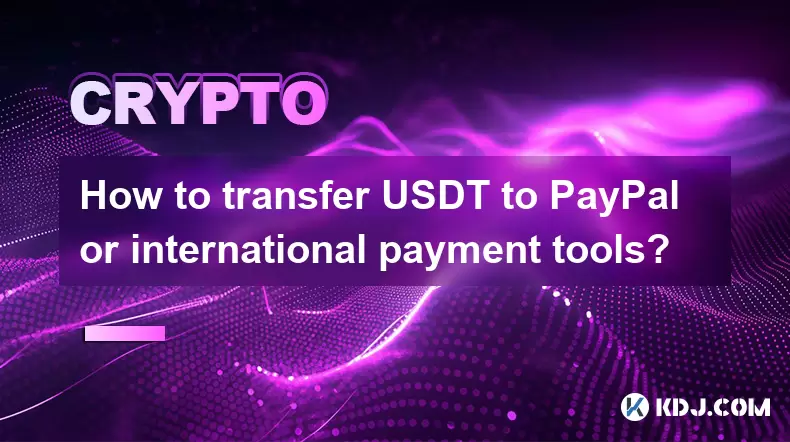
How to transfer USDT to PayPal or international payment tools?
Jun 15,2025 at 05:28am
Understanding the Basics of USDT and PayPal IntegrationUSDT (Tether) is a stablecoin pegged to the US dollar, offering blockchain-based value transfer...
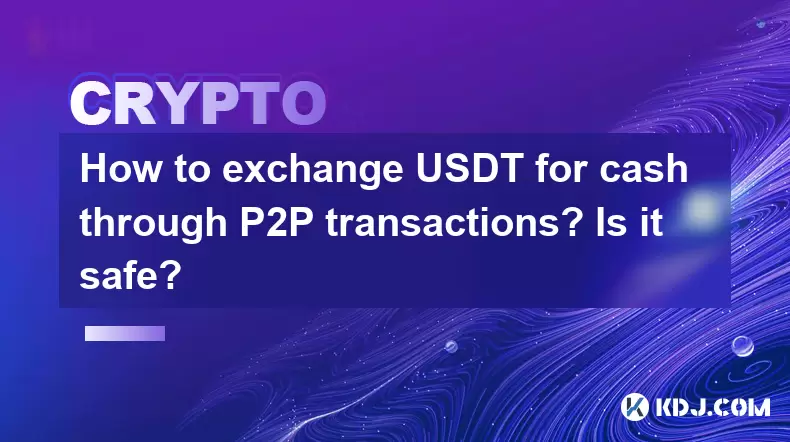
How to exchange USDT for cash through P2P transactions? Is it safe?
Jun 18,2025 at 07:56am
Understanding USDT and P2P TransactionsTether (USDT) is a stablecoin pegged to the value of the US dollar, making it a popular choice for users who wa...
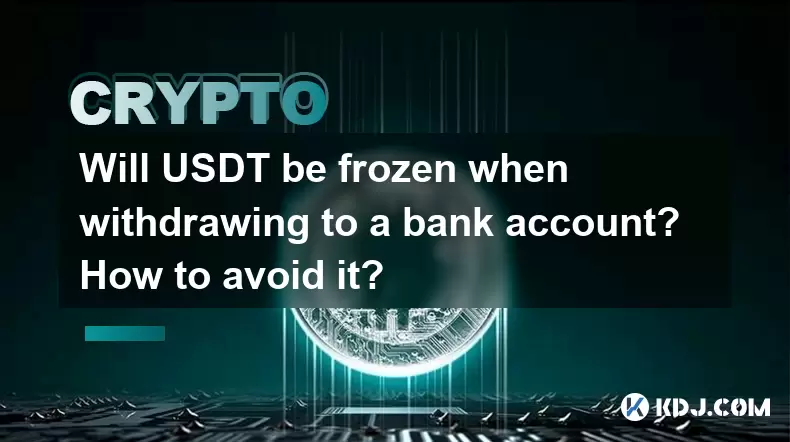
Will USDT be frozen when withdrawing to a bank account? How to avoid it?
Jun 15,2025 at 10:03am
Understanding USDT Withdrawals and Bank Account Freezing RisksWhen users decide to withdraw USDT (Tether) to a bank account, one of the most common co...
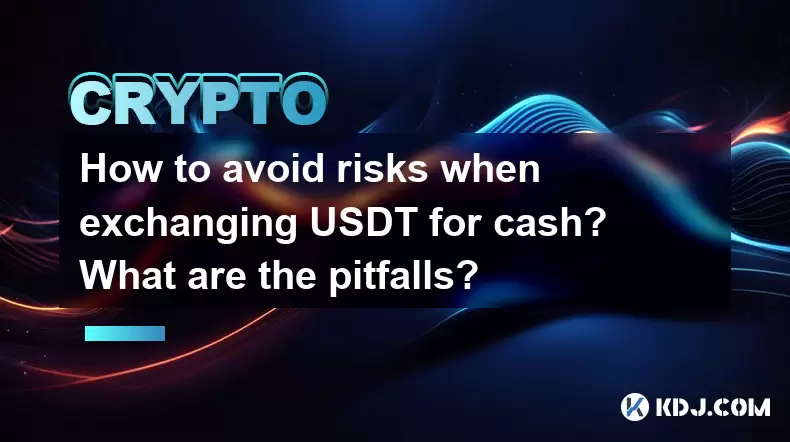
How to avoid risks when exchanging USDT for cash? What are the pitfalls?
Jun 11,2025 at 08:14pm
Understanding the Risks of Exchanging USDT for CashWhen exchanging USDT (Tether) for cash, users must be aware of the potential risks involved. As a s...

How to choose a reliable USDT exchange service provider? How to identify?
Jun 12,2025 at 03:15pm
Understanding the Role of USDT in Cryptocurrency TradingUSDT (Tether) is one of the most widely used stablecoins in the cryptocurrency market. It is d...

What is the most convenient way to cash out small amounts of USDT? Is there a shortcut?
Jun 11,2025 at 11:00pm
Understanding the Need to Cash Out Small USDT AmountsCashing out small amounts of USDT can be a challenge for many crypto users. Traditional methods o...

How to transfer USDT to PayPal or international payment tools?
Jun 15,2025 at 05:28am
Understanding the Basics of USDT and PayPal IntegrationUSDT (Tether) is a stablecoin pegged to the US dollar, offering blockchain-based value transfer...

How to exchange USDT for cash through P2P transactions? Is it safe?
Jun 18,2025 at 07:56am
Understanding USDT and P2P TransactionsTether (USDT) is a stablecoin pegged to the value of the US dollar, making it a popular choice for users who wa...

Will USDT be frozen when withdrawing to a bank account? How to avoid it?
Jun 15,2025 at 10:03am
Understanding USDT Withdrawals and Bank Account Freezing RisksWhen users decide to withdraw USDT (Tether) to a bank account, one of the most common co...

How to avoid risks when exchanging USDT for cash? What are the pitfalls?
Jun 11,2025 at 08:14pm
Understanding the Risks of Exchanging USDT for CashWhen exchanging USDT (Tether) for cash, users must be aware of the potential risks involved. As a s...
See all articles

























































































